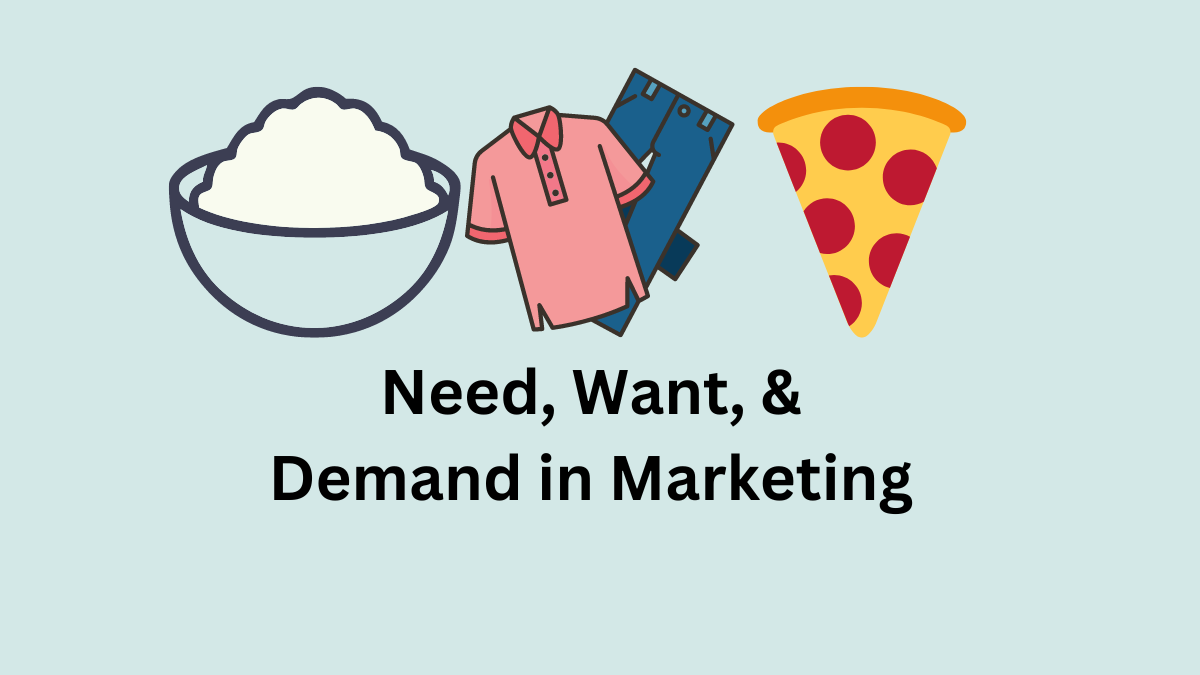Need, Want, and Demand in Marketing
The need, want, and demands are the key components of core marketing concepts. These concepts guide marketers to offer products tailored to customers.
Needs are the base, wants to add flavor, and demands drive action. Balancing these shapes successful marketing strategies, matching products to people’s desires and means. In this dynamic interplay, marketers create connections that move products from necessity to desire and finally to ownership.
In this article we will understand what need, want, and demand is and the similarities and differences between them. Let’s get started.
What are Needs?
In the realm of marketing, a “need” is a fundamental necessity for human survival and well-being. It includes basic requirements like food, shelter, clothing, and safety. But needs to extend beyond the essentials, embracing education and healthcare in the modern world. There are six types of needs: physiological, safety, social, esteem, self-actualization, and self-transcendence, as defined by Maslow’s Hierarchy of Needs.
Related: Consumer Needs
Physiological needs involve hunger and thirst; safety needs encompass security and protection. Social needs connect us with others, while esteem needs relate to self-worth. The higher levels involve self-actualization, fulfilling personal potential, and self-transcendence, focusing on helping others.
Influencing factors like cultural norms, social conditions, and individual circumstances shape our needs. For instance, people in colder climates might prioritize warm clothing due to their environment. Recognizing and catering to these diverse needs is crucial for marketers, enabling them to create products and services that resonate with customers on a deep level, enhancing their lives and fulfilling their core desires.
What are Wants?
In the world of marketing, a “want” goes beyond basic needs, representing desires for specific items or experiences. Wants are shaped by individual preferences, cultural influences, and personal choices. They often bring comfort and enjoyment to our lives, even if they aren’t essential for survival. There are various types of wants, stemming from diverse factors like lifestyle, environment, and societal norms.
The consumer wants might include items like smartphones, fashionable clothing, or gourmet foods. In contrast, cultural wants could be traditional clothing or rituals. Convenience wants revolve around time-saving products like ready-made meals, while emotional wants involve products that evoke certain feelings, such as luxury goods or sentimental items.
Influencing factors play a significant role in shaping wants. These include advertising, social media, peer pressure, and personal experiences. For example, seeing a celebrity endorse a product might create a desire for it. By understanding the different types of wants and their driving forces, marketers can tailor their strategies to resonate with consumers’ desires, offering products that fulfill their wants and enrich their lives.
What are Demands?
Demand in marketing is the culmination of customer needs and wants, backed by the ability and willingness to purchase. It represents the desire for specific products or services that customers are not only interested in but also ready to buy. Demand is a crucial concept, guiding businesses in understanding customer preferences and making informed decisions.
Read Also: What is Market?
There are different types of demand: negative demand, where customers dislike a product; no demand when customers are unaware of or uninterested in a product; latent demand, where customers don’t realize their need until it’s addressed; declining demand, due to changing trends; irregular demand, seen in seasonal products; full demand, where supply meets demand; and overfull demand when demand exceeds supply.
Factors influencing demand include social factors like awareness and norms, and emotional factors like sentiments. For instance, increasing awareness about healthy lifestyles impacts the demand for organic foods. Understanding these types and factors helps marketers tailor strategies to meet customer demands effectively, offering products and services that fulfill both practical needs and emotional desires.
Need Vs. Want Vs. Demand
Need, Want, and Demand are pivotal in the realm of marketing, elucidating distinct aspects of consumer behavior and market dynamics.
Distinguishing them, needs are essentials, wants are desires, and demand indicates the purchasing potential. However, they intertwine – a need for sustenance transforms into a want for premium cuisine, and if bought, it becomes a demand.
Arti Kushmi holds a BBS (Bachelor in Business Studies) degree and shares her business and marketing knowledge through this website. While not writing she will be reading and enjoying the moment.
